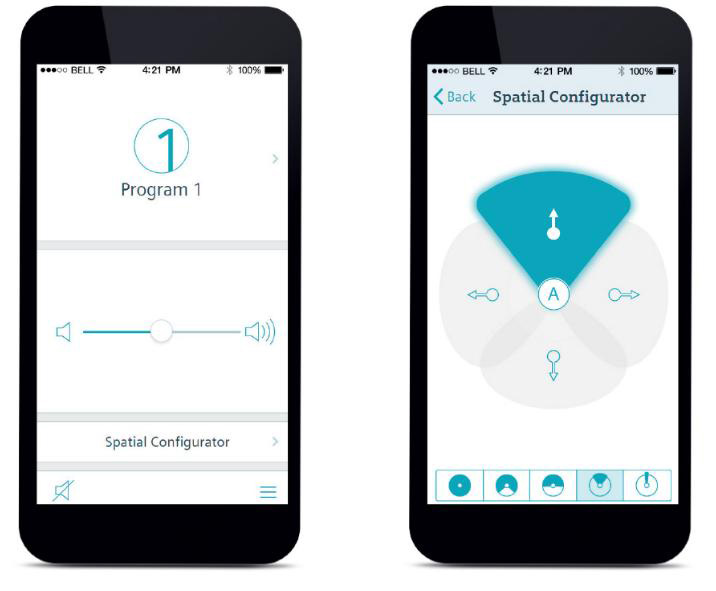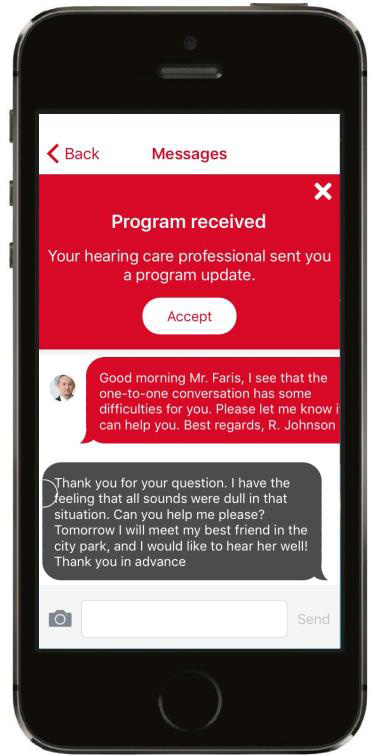Motion SP: The New Super Power
Rebecca Herbig, Au.D.
Introduction
Although only a small percentage of our patients suffer from severe to profound hearing loss, designing the ideal hearing solution for them brings unique challenges. With their particular listening needs in mind, Signia has offered generations of hearing solutions with increasingly sophisticated technology. Our previous super-power instrument, Nitro micon, was exceptionally well received due to several key advantages including a dedicated super-power fit, frequency compression, and a powerful automatic directional microphone system (Serman, Giese, & Pischel, 2014). The new Motion SP builds upon Nitro micon’s proven strategies and brings primax innovations to patients with severe to profound hearing loss.
Unprecedented speech intelligibility
Compared to those with milder hearing loss, patients with severe to profound hearing loss exhibit inner hair cell damage in addition to outer hair cell damage. As a result, in addition to reduced audibility, they also have problems associated with broadened auditory filters. These include reduced ability to differentiate two different signals in the frequency domain, more difficulty hearing the target speech in competing background noise, and greater susceptibility to distortion (Souza, Jenstad, & Folino, 2005). As a result, the benefit this patient group can derive from directional technology in noisy situations is potentially substantial.
Narrow Directionality, the automatic binaural beamforming technology in primax SPEECH, has been proven repeatedly to provide unprecedented directional benefit, dramatically improving speech intelligibility in complex, diffuse, noisy environments. (Powers & Fröhlich, 2014, Froehlich, Freels, & Powers, 2015, Dillon, 2016). More importantly, it has been proven also to provide significant benefit even for those with severe hearing loss. Research conducted at Vanderbilt University showed that Narrow Directionality provided about 2 dB SRT-in-Noise benefit over traditional directional technology, and almost 5 dB benefit over TruEar (mild directional mode in the high frequencies designed to mimic the directional properties of the outer ear). These differences were statistically significant, and similar to those shown in earlier studies conducted with patients who had less hearing loss. (Powers & Littmann, 2016).
Reduced listening effort throughout the day
Hearing loss degrades our ability to perceive the speech signal, thereby increasing the demands on cognitive resources involved in selectively attending and interpreting it. The increase in cognitive activity needed for the compensation of missing speech details in difficult listening situations is experienced as effortful listening and will eventually lead to listening fatigue. In other words, to improve the overall listening experience, one has to consider both the ability to understand speech, and the listening effort required. People with even mild hearing loss exert more listening effort than people with normal hearing, and therefore it is likely that as hearing loss increases, so does listening effort.
Listening effort can be reduced by removing noise and highlighting speech. The primax SPEECH achieves both effects, for a wide variety of listening environments throughout the day. More than a single feature or innovation, SPEECH is the engine responsible for the automation of the Universal program, and steers a conglomerate of algorithms and processes including gain parameters, noise reduction, and the directional microphone system (Herbig & Froehlich, 2016). As a result, SPEECH is able to focus on the loudest speech source while reducing the intensity of all other competing sounds. By measuring brain activity as shown in EEG recordings, primax SPEECH has been objectively shown to reduce wearer listening effort (Littmann, et. al., 2016).
Giving patients the control over their hearing experience
While patients with more severe hearing loss can benefit just as much from directional technology as those with milder hearing loss, the former group has sometimes shown more preference for maintaining control of their hearing aid behavior over automatic steering. More often than not, patients with severe to profound hearing loss are very experienced hearing aid wearers, many of whom have used amplification most of their lives. They know exactly how they like to hear in each situation, and as a result, have greater appreciation for the ability to control their hearing aids in various listening situations.
Motion SP is compatible with a variety of control options that will fit the preferences of these experienced wearers.
- Smartphone apps. Like all Signia hearing aids, Motion SP is compatible with the touchControl app, easyTek app, and TeleCare myHearing app. The most comprehensive, intuitive, yet discreet way to control hearing aid functionalities, Signia smartphone apps allow users to manipulate a variety of hearing aid functionalities easily (Herbig et al, 2015). Beyond the standard control options such as volume, program, and tone balance, Motion SP primax also allows the wearer to directly adjust behavior of the directional microphone system (Varallyay, Pape, & Meyers, 2015). Via clear and intuitive visual displays on the smartphone, the wearer can adjust the width of the microphone focus beam, as well as the focus direction (front, back, either side) via Spatial Configurator. This added adjustment possibility will be especially appreciated by individuals with more significant hearing loss who may have very defined preferences in how they want to hear in different, noisy situations (Figure 1).

Figure 1. The touchControl app allows the wearer to control not only basic hearing aid functions such as volume and program (left), but also directional microphone behavior (right).
- miniPocket. While more and more of our hearing aid users are adopting new technology, not all own smartphones. miniPocket is a traditional remote control with large, intuitive buttons designed for these individuals.
- Onboard controls. Motions SP also has onboard controls which can be programmed to adjust volume, listening program, tinnitus therapy volume, and tone. While those with less hearing loss are often willing to forgo onboard controls in favor of a smaller-sized instrument, onboard controls are oftentimes a preferred means of hearing aid adjustments for these experienced wearers who may have been using them for decades. Motion SP features both a push button and a rocker switch, which gives the hearing aid user more adjustment flexibility. In a bilateral fitting, each rocker switch can be programmed to adjust different functionalities in both hearing aids. For example, one can be programmed to adjust volume simultaneously in both aids, while the other rocker switch can be programmed to adjust tinnitus sound therapy volume in both aids.
Unparalleled access to professional hearing care
More than just the hearing aid, Motion SP’s compatibility with Signia TeleCare means that the wearer and hearing care professional can enjoy an unparalleled level of connectedness during the initial trial period and beyond. TeleCare was designed to cover the “blind spot” of the initial home trial period when patients are sent home with their new hearing aids without the close guidance of the hearing care professional (Ramirez, 2016, Varallyay, & Herbig, 2016).
While attractive for new users who are experiencing amplification for the first time, Motion SP patients will also appreciate all the benefits TeleCare brings. Again, this is because these very experienced patients are often very particular about how they like their hearing aids to sound in a wide variety of situations. TeleCare allows them to contact their hearing care professionals via text or voice call using the myHearing app and raise their concerns about their hearing aids’ performance in specific listening situations on the spot (Figure 2). Not only is the hearing care professional able to counsel and advise the patient directly, he or she is also able to make remote hearing aid setting adjustments and send it via the app for the patient to try out immediately. In this way, TeleCare ensures that these highly demanding and discerning patients stay satisfied with their new Motion SP aids during the initial trial period, and beyond.

Figure 2. The TeleCare myHearing app allows wearers and their hearing care professionals to communicate easily during the trial period. Wearers can raise questions and concerns, and the hearing care professional can respond, and even remotely make hearing aid adjustments.
Super power Fit for Super power wearers
By selecting the dedicated proprietary fitting formula “primax fit” when using Motion SP, the patient is not only enjoying the proven super-power fit similar to Nitro micon, he will also derive maximum benefit from the powerful primax SPEECH when choosing the More Compressive fitting option. For those patients more used to linear amplification, the option remains to choose a More Linear fit. When cochlear dead regions are suspected, primax fit recommends the appropriate frequency compression scheme. Hearing care professionals will also appreciate the convenient Basic Tuning option to directly change the fitting to more compressive or more linear when fitting Motion SP. More information regarding the Signia super-power fitting rationales can be found in the whitepaper by Serman, Giese, & Pischel (2014).
Designed to maximize usability
Motion SP’s unparalleled audiological features inside are coupled with practical physical features. In addition to compatibility with the easyTek streamer accessory, it features a built-in Telecoil and direct audio input for maximum connectivity options. With pediatric patients in mind, Motion SP has an ergonomic slim-neck design, LED status indicator, and optional pediatric safety features such as battery door and control locks. Durable and robust, it is rated IP 67 for resistance against moisture, sweat, and dust. It is also compatible with CROS Pure transmitter for CROS and BiCROS fittings.
Conclusion
Motion SP is the latest Signia product dedicated to those with severe to profound hearing loss. It is grounded in proven technology, and made even better with the latest primax innovations. Beyond the hearing aid itself, its wide variety of remote control and connectivity options, as well as the unparalleled access to the hearing care professional made possible by TeleCare makes it the ideal choice for those with severe to profound hearing loss.
References
Dillon, H. (2016). Listening in Noise. Presented at World Congress on Audiology. Vancouver. Retrieved in Dec. 2016 from http://www.nal.gov.au/conference-presentations_tab_19.shtml
Froehlich, M., Freels, K., & Powers, T. (2015). Speech recognition benefit obtained from binaural beamforming hearing aids: comparison to omnidirectional and individuals with normal hearing AudiologyOnline, Article 14338. Retrieved from www.audiologyonline.com
Herbig, R., & Froehlich, M. (2016). Reducing listening effort via primax hearing technology. AudiologyOnline, Article 17275. Retrieved from www.audiologyonline.com
Herbig, R., Lotter, T., Sauer, G., & Dickel, T. (2015). Connecting smartphones to hearing instruments with acoustic wireless control. Audiology Today, 25(6), 50-55.
Littmann, V., Froehlich, M., Beilin, J., Branda, E., & Schaefer, P. (2016). Clinical studies show advanced hearing aid technology reduces listening effort. Hearing Review, 23(4), 36.
Powers, T. A., & Fröhlich, M. (2014). Clinical results with a new wireless binaural directional hearing system. Hearing Review, 21(11), 32-34.
Ramirez, P. (2016). Telehealth apps and hearing aid trial periods: new technology to revolutionize patient care. Hearing Review, 23(12), 28.
Serman, M., Giese, U., & Pischel, C. (2014). Nitro micon: the Wisdom behind the Powerful Sound. Siemens Whitepaper.
Souza, P., Jenstad, L., &Folino, R. (2005). Using multichannel wide-dynamic range compression in severely hearing-impaired listeners: effects on speech recognition and quality. Ear & Hearing, 26(2), 120-131.
Varallyay, G., & Herbig, R. (2016). Signia TeleCare: The Future of Hearing Care Starts Now. Sivantos Whitepaper.
Varallyay, G., Pape, S., & Meyers, C. (2015). Automatic steering: the director of the binax soundtrack. AudiologyOnline, Article 14353. Retrieved from www.audiologyonline.com.
